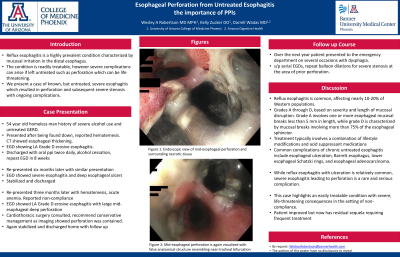Back


Poster Session C - Monday Afternoon
Category: Esophagus
C0243 - Esophageal Perforation - The Importance of PPIs
Monday, October 24, 2022
3:00 PM – 5:00 PM ET
Location: Crown Ballroom

Has Audio

Wesley A. Robertson, MD, MPH, MPA
University of Arizona College of Medicine
Phoenix, AZ
Presenting Author(s)
Wesley A. Robertson, MD, MPH, MPA1, Kelly Zucker, DO1, Darrell Wadas, MD2
1University of Arizona College of Medicine, Phoenix, AZ; 2Arizona Digestive Health, Phoenix, AZ
Introduction: Reflux esophagitis is a highly prevalent condition characterized by mucosal irritation in the distal esophagus. The condition is readily treatable, however severe complications can arise if left untreated such as perforation which can be life threatening. We present a case of known, but untreated, severe esophagitis which resulted in perforation and subsequent severe stenosis with ongoing complications.
Case Description/Methods: A 54 year old homeless man with medical history of severe alcohol use and untreated gastroesophageal reflux. He initially presented to the hospital after being found down with reported hematemesis. CT on admission showed esophageal thickening. GI performed an esophagogastroduodenoscopy (EGD) showing LA Grade D erosive esophagitis. He was discharged with oral ppi twice daily, recommended alcohol cessation, and advised to undergo a repeat EGD in approximately 8 weeks to assess healing and evaluate underlying mucosa.
Six months later, he had a nearly identical presentation, and an EGD showed severe esophagitis and deep esophageal ulcers. He was stabilized and discharged with similar recommendations. Three months later he presented again to the hospital with hematemesis and acute anemia. He had been non-compliant with medications and GI again performed an EGD which demonstrated LA Grade D erosive esophagitis with large mid-esophageal deep perforation resulting in a bifurcation as seen in Figure 1. Cardiothoracic surgery was consulted and recommended conservative management as imaging showed the perforation was contained. Patient was stabilized and discharged home with GI follow up.
Over the next year patient presented to the emergency department on several occasions with dysphagia. He has since undergone serial EGDs with repeat balloon dilations for severe stenosis at the area of prior perforation.
Discussion: While reflux esophagitis with ulceration is relatively common, severe esophagitis leading to perforation is a rare and serious complication. This case highlights an easily treatable condition with severe, life-threatening consequences in the setting of non-compliance. Fortunately, our patient improved but now has residual sequela requiring frequent treatment as the patient had limited resources to obtain medications and was consistently non-compliant.

Disclosures:
Wesley A. Robertson, MD, MPH, MPA1, Kelly Zucker, DO1, Darrell Wadas, MD2. C0243 - Esophageal Perforation - The Importance of PPIs, ACG 2022 Annual Scientific Meeting Abstracts. Charlotte, NC: American College of Gastroenterology.
1University of Arizona College of Medicine, Phoenix, AZ; 2Arizona Digestive Health, Phoenix, AZ
Introduction: Reflux esophagitis is a highly prevalent condition characterized by mucosal irritation in the distal esophagus. The condition is readily treatable, however severe complications can arise if left untreated such as perforation which can be life threatening. We present a case of known, but untreated, severe esophagitis which resulted in perforation and subsequent severe stenosis with ongoing complications.
Case Description/Methods: A 54 year old homeless man with medical history of severe alcohol use and untreated gastroesophageal reflux. He initially presented to the hospital after being found down with reported hematemesis. CT on admission showed esophageal thickening. GI performed an esophagogastroduodenoscopy (EGD) showing LA Grade D erosive esophagitis. He was discharged with oral ppi twice daily, recommended alcohol cessation, and advised to undergo a repeat EGD in approximately 8 weeks to assess healing and evaluate underlying mucosa.
Six months later, he had a nearly identical presentation, and an EGD showed severe esophagitis and deep esophageal ulcers. He was stabilized and discharged with similar recommendations. Three months later he presented again to the hospital with hematemesis and acute anemia. He had been non-compliant with medications and GI again performed an EGD which demonstrated LA Grade D erosive esophagitis with large mid-esophageal deep perforation resulting in a bifurcation as seen in Figure 1. Cardiothoracic surgery was consulted and recommended conservative management as imaging showed the perforation was contained. Patient was stabilized and discharged home with GI follow up.
Over the next year patient presented to the emergency department on several occasions with dysphagia. He has since undergone serial EGDs with repeat balloon dilations for severe stenosis at the area of prior perforation.
Discussion: While reflux esophagitis with ulceration is relatively common, severe esophagitis leading to perforation is a rare and serious complication. This case highlights an easily treatable condition with severe, life-threatening consequences in the setting of non-compliance. Fortunately, our patient improved but now has residual sequela requiring frequent treatment as the patient had limited resources to obtain medications and was consistently non-compliant.

Figure: Figure 1: Endoscopic view of mid-esophageal perforation and surrounding necrotic tissue
Disclosures:
Wesley Robertson indicated no relevant financial relationships.
Kelly Zucker indicated no relevant financial relationships.
Darrell Wadas indicated no relevant financial relationships.
Wesley A. Robertson, MD, MPH, MPA1, Kelly Zucker, DO1, Darrell Wadas, MD2. C0243 - Esophageal Perforation - The Importance of PPIs, ACG 2022 Annual Scientific Meeting Abstracts. Charlotte, NC: American College of Gastroenterology.
